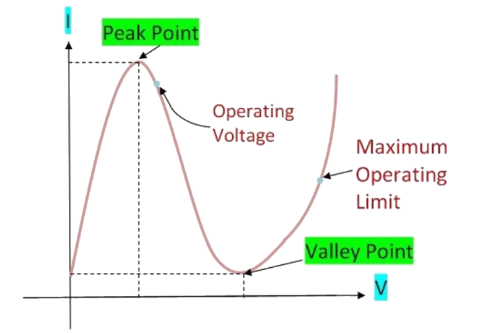V-I Characteristics of Gunn Diode.
Introduction
The Gunn Oscillator is based on negative differential conductivity effect in bulk semiconductor which has two conduction bands, minima separated by an energy gap. A disturbance at the cathode gives rise to high field region which travel towards the anode. When this high field domain reaches the anode, it disappears and another domain is formed at the cathode and starts moving towards anode and so on. The time required for domain to travel from cathode to anode gives oscillation frequency. In a Gunn Oscillator, the Gunn diode is placed in a resonant cavity, the Oscillation frequency is determined by cavity dimension than by diode itself.
Modes of Operation of Gunn Diode
The operation of a Gunn diode can be done in four modes which include the following.
- Gunn Oscillation Mode
- Stable Amplification Mode
- LSA Oscillation Mode
- Bias Circuit Oscillation Mode
V-I Characteristics of Gunn Diode
The Current in Gunn diode starts increasing initially with the applied DC voltage. At a particular point, the current starts decreasing this point is called threshold point or peak point.

Fig. 1 V-I Characteristics of Gunn Diode
After crossing threshold point the current starts decreasing and this creates negative resistance region in the diode. Due to this negative resistance region, the diode acts as amplifier and oscillator. In this negative resistance region, the Gunn diode is able to amplify the signals.
Component Used for Characteristics of Gunn Diode
GUNN Power Supply
Provides the necessary DC voltage to the Gunn diode, enabling it to operate in its oscillation region and generate microwave signals.GUNN Oscillator
A circuit configuration that uses the Gunn diode to produce continuous microwave oscillations. It is essential for generating stable RF signals for measurement.Pin Modulator
Controls the amplitude of the output signal by varying the input power to the Gunn diode, allowing for modulation of the signal, which is useful for testing and analysis.Isolator
Prevents reflected signals from returning to the Gunn diode, protecting it from potential damage and ensuring stable operation by maintaining unidirectional signal flow.Attenuator
Allows for precise control of the signal power reaching the detector, enabling adjustments to observe the effects of power levels on the diode’s performance.Frequency Meter
Measures the frequency of the output signal from the Gunn oscillator, allowing for precise tuning and characterization of the oscillation frequency.Detector
Measures the power of the microwave output signal, providing a way to analyze the performance and characteristics of the Gunn diode.VSWR Meter
Measures the Voltage Standing Wave Ratio (VSWR), which indicates the efficiency of power transmission from the Gunn diode to the load. A low VSWR indicates good impedance matching.
Block Diagram

Fig. 2 Bench setup for V-I Characteristics of Gunn Diode
Advantages of Gunn diode
- Portable and Small Size device.
- The cost of manufacturing of Gunn diode is low.
- It possesses better noise to signal ratio as it is immune from noise disturbance.
- The Gunn diode is reliable and stable at higher frequencies.
- It has a high bandwidth of operation.
Disadvantages of Gunn Diode
- The Gunn diode has poor temperature stability.
- The device operating current is higher and therefore power dissipation is more.
- The efficiency of Gunn Diode is low below 10GHz.
